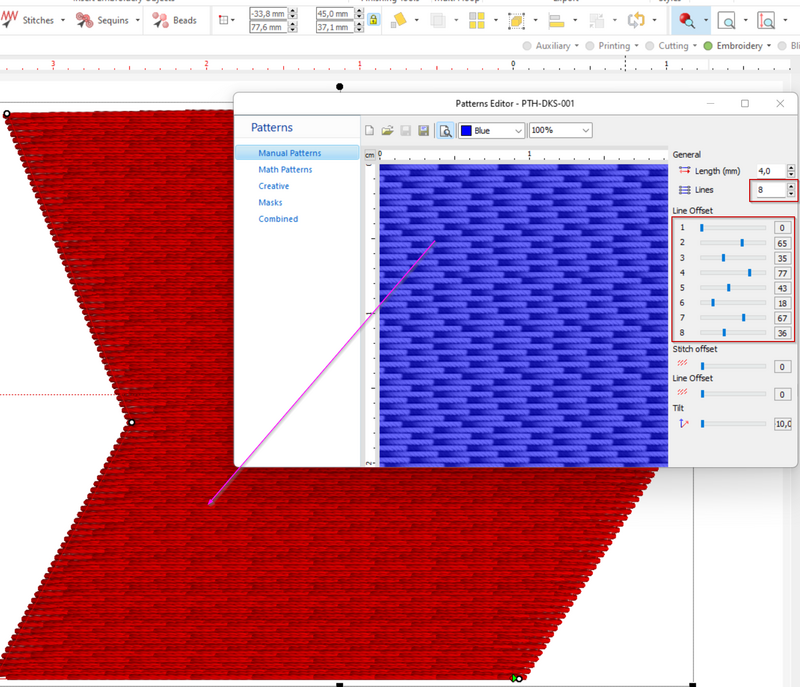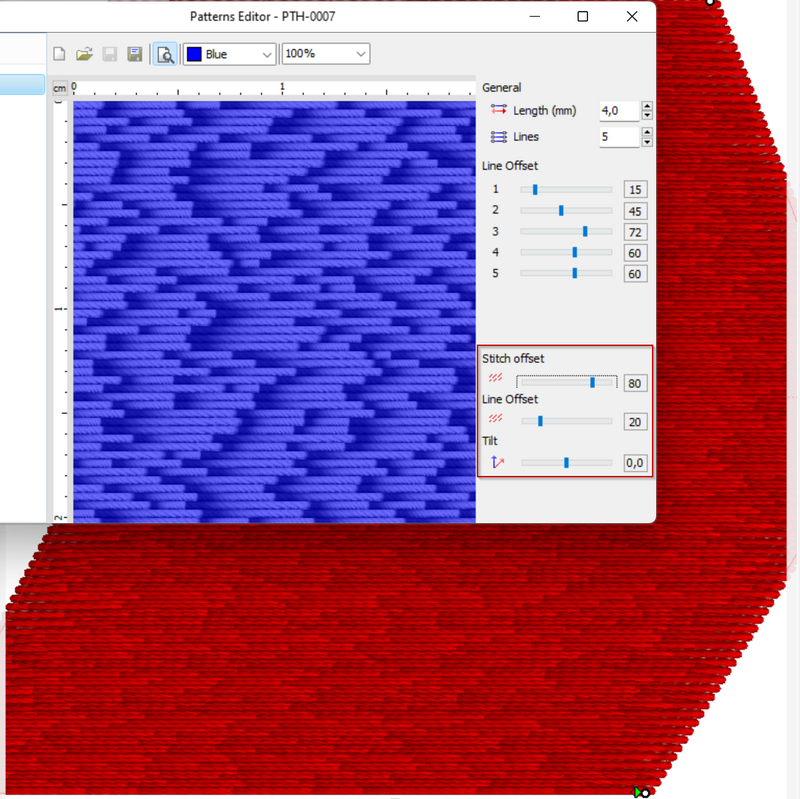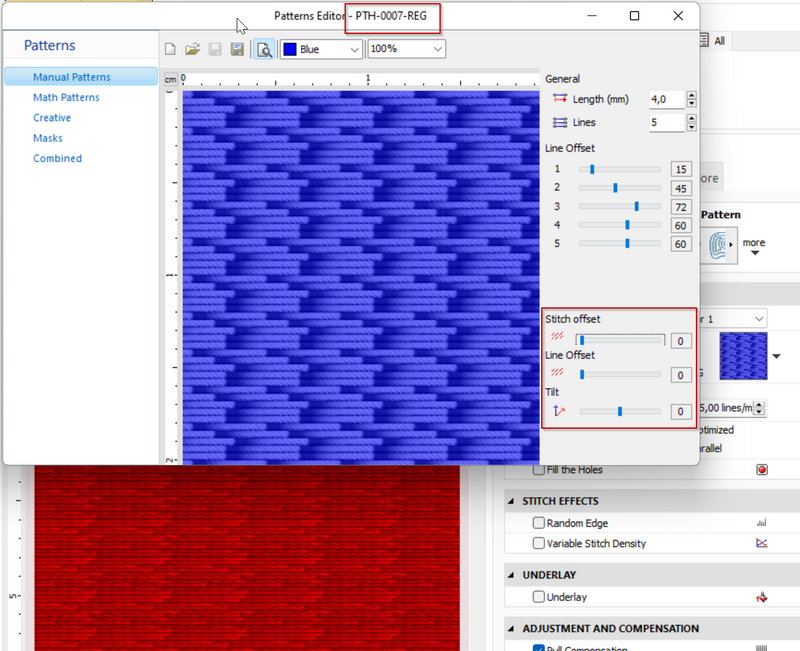Tatami embroidery fill patterns: Difference between revisions
| Line 75: | Line 75: | ||
* We did not add any additional stitch and line offsets that would create a totally irregular design. | * We did not add any additional stitch and line offsets that would create a totally irregular design. | ||
[[File:EO23-pattern-editor-1.png|alt=Screenshot of Embroidery Office 23 Pattern Editor - manual fill|none|thumb|800x800px|Screenshot of Embroidery Office 23 Pattern Editor - manual fill]] | [[File:EO23-pattern-editor-1.png|alt=Screenshot of Embroidery Office 23 Pattern Editor - manual fill|none|thumb|800x800px|Screenshot of Embroidery Office 23 Pattern Editor - a regular "rough" manual fill]] | ||
Let us look at fairly irregular system pattern with some sort of rough "patches". This effect is achieved by changing stitch and line offset. | |||
[[File:EO23-pattern-editor-2.png|alt=Screenshot of Embroidery Office 23 Pattern Editor - manual fill|none|thumb|800x800px|Screenshot of Embroidery Office 23 Pattern Editor - an irregular manual fill]] | |||
[[File:EO23-pattern-editor-3.png|alt=Screenshot of Embroidery Office 23 Pattern Editor - manual fill|none|thumb|800x800px|Screenshot of Embroidery Office 23 Pattern Editor - stitch and line offset of the above example removed]] | |||
There is no export or import facility, but we believe that files can be copied manually between machines that have the same software installed (to be verified) | There is no export or import facility, but we believe that files can be copied manually between machines that have the same software installed (to be verified) | ||
Revision as of 11:01, 2 June 2023
Introduction
Tatami fill patterns are one major type of stitch types (the others are lines, satin stitches and programmed stitches).
Each software manufacturer its own way of defining these. Generally speaking, one can find a few dozen non-editable patterns in semi-professional software. Professional software has more and allows creating new patterns, or modifying existing patterns,.
Typology of tatami fill patterns
Tatami fill patterns define an area where the threads are stitched in lines (in parallel to each other). Position of stitch points in a set of lines allow creating different types of patterns.
Pattern editing with embroidery software
Professional embroidery design software lets users design their own patterns. As far as we can tell, underlying logic is similar, but the way pattern structure and editing tools are implemented is quite different. Below we compare a few editors.
DG 15 (Tajima)
DG 15 distinguishes between standard (regular) fill pattern, complex patterns, carved fill patterns
DG 15 standard patterns
According to chapter 11 of the DG 15 User's guide [1], a user can modify or create patterns using the standard patterns dialog. Standard patterns are defined by lines that have the same distance between stitches but are offset. The following can be defined
- Length of stitches (points), i.e. total length of a repeatable pattern line, e.g. 40
- Number of offsets (i.e. lines that will be stitched before the pattern repeats, typically 4 for simple design and over 10 for complex designs)
- For each offset, a percentage between 0 and 100 that defines the offset can be defined. Alternatively the patterns are displayed with lines and beads representing stitches. The lines with beads then can be moved up and down.
Carved fills are created with complex fill segments on top of which carved fill patterns are applied (chapter 11, page 221). Carved fill patterns can also be used with true type fonts.
Embroidery Office 23
Embroidery office (EO), as well as the semi-professional Stitch Era product line, distinguishes between four types of tatami fills:
- Manual Patterns (~140 variants) = defined by several lines with a different offset for each.
- Math Patterns = defined by a line that is repeated with various offsets and a tilt
- Creative Patterns = defined with a kind of pixel editor.
- Combined Patterns = another pattern with a mask on top
- Masks (to be used with the others)
Fills can be created through (Menu Embroidery -> System libraries -> Embroidery Components -> Patterns)
EO Manual patterns
Manual patterns in Embroidery Office 23 are defined by the following elements:
- A number of lines
- A length of the stitches (4mm by default)
- An offset for each line
- An optional stitch offset
- An optional line offset
- An optional tilt
Let us look a slightly "rough" pattern fill that we defined ourselves
- It has 8 lines (the maximum possible)
- Stitch length is 4mm
- Line starts and ends go "forth and back"
- We did not add any additional stitch and line offsets that would create a totally irregular design.
Let us look at fairly irregular system pattern with some sort of rough "patches". This effect is achieved by changing stitch and line offset.
There is no export or import facility, but we believe that files can be copied manually between machines that have the same software installed (to be verified)
- from C:\ProgramData\Sierra\Design\Resources
- e.g. "C:\ProgramData\Sierra\Design\Resources\PTH-DKS-001.manpat"
References
- ↑ Pulse (2014), Using Tajima DG15 by Pulse. Retrieved from https://help.hsi.us/hc/en-us/articles/231740607-DG15-User-s-Guide-and-Release-Notes



